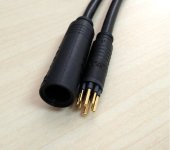What is the maximum current (and voltage) that the standard moulded 9-pin motor connector can tolerate?
I'm talking about this connector:

I searched around on the forum, and got unsubstantiated answers between 12 amps and 30 amps. I didn't find any reports of a failure of this connector.
I believe the connector is made by Julet, and rebranded by 8FUN. I could be wrong - 8FUN might be making their own version.
I build ebikes for a living, and have used this cable at 52V 20A and 36V 25A regularly and without issue. I had one failure of the female end, but I believe that was from one of the pins becoming displaced and not from overheating.
Please report on your experience (and current/volts) with this connector, and any failures you have encountered. I am particularly curious if it can reliably operate at 52V 30A.
I'm talking about this connector:

I searched around on the forum, and got unsubstantiated answers between 12 amps and 30 amps. I didn't find any reports of a failure of this connector.
I believe the connector is made by Julet, and rebranded by 8FUN. I could be wrong - 8FUN might be making their own version.
I build ebikes for a living, and have used this cable at 52V 20A and 36V 25A regularly and without issue. I had one failure of the female end, but I believe that was from one of the pins becoming displaced and not from overheating.
Please report on your experience (and current/volts) with this connector, and any failures you have encountered. I am particularly curious if it can reliably operate at 52V 30A.

